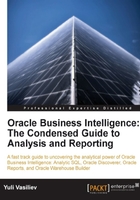
While often used interchangeably, data and information do not mean the same thing. In a few simple words, data is what you can save, transform, or retrieve, whereas information is what you normally use in a decision-making process. On the other hand, these two terms are very closely related, as information is taken out of data. And sometimes, it may be quite sufficient to take a glance at your data by issuing a simple query, obtaining the required information, and getting your question answered.
Having data, though, does not automatically mean having information. In general terms, obtaining information is a process of transforming data. Depending on the information you need, the process of extracting information from data may be as simple as issuing a simple SQL query against it, or may be complex enough that it requires you to issue a great deal of complicated analytical queries against data stored in different sources, and in different formats.
SQL, which has been the primary tool for extracting information from data for decades, hits its ceiling when it comes to answering business analysis questions. The problem is not only in that it is sometimes too hard to write SQL statements that reflect required business functionality, but also that SQL is designed to work only with structured data stored in a relational database, while you may need to access unstructured or semi-structured data.
The limitations of SQL pushed some vendors to come up with BI (Business Intelligence) tools, which simplify the process of analyzing and publishing business data stored in both a database and external sources, thus enabling better decision-making. Using BI tools, you can easily prepare your data, wherever it is found, for analysis and reporting, thus creating and maintaining a business-oriented view of it.
This book introduces Oracle Business Intelligence, a suite of high-end tools from Oracle, which provide an effective means of delivering information, analysis, and efficiencies. You will learn how to use these powerful tools to your advantage when it comes to accessing the data that's available from a number of different sources and extracting the information you need to run your business.
As mentioned earlier, the book introduces the Oracle Business Intelligence platform, providing a suite of examples to help illustrate some key concepts. Here's a synopsis of what you will find in the book:
Chapter 1, Getting Business Information from Data, explains the concepts behind getting business information from data, giving you a basic understanding of what you need to answer your business questions promptly and efficiently.
Chapter 2, Introducing Oracle Business Intelligence, gives a comprehensive overview of the components included in the Oracle Business Intelligence package, as well as the Oracle Business Intelligence Tools package. It also explains how to install these packages on your machine. Although the installation process is given for Windows, it's similar for the other operating systems on which you might install this software.
Chapter 3, Working with Database Data, describes how to access and analyze data extracted from various sources, including Oracle Database and external source systems. You'll learn how to access and analyze relational data, leveraging the Business Intelligence features of Oracle Database as well as its computational power.
Chapter 4, Analyzing Data and Creating Reports, demonstrates the use of Oracle Business Intelligence components to analyze data and create reports, processing information that comes from the data you collect during business transactions. In particular, you'll look at Oracle Reports, Oracle BI Discoverer Plus, and Oracle BI Spreadsheet Add-In.
Chapter 5, Warehousing for Analysis and Reporting, explains the role of data warehousing for analysis and reporting, discussing how to build and use a Data Warehouse in an Oracle database. The chapter examples illustrate how you can integrate data from different transactional systems, facilitating business analysis with warehousing.
Chapter 6, Pivoting Through Data, discusses the use of pivoting to arrange data for effective analysis. You will look at how to change the layout or contents of an Oracle BI Discoverer Plus report, taking advantage of the slice and dice capability.
Chapter 7, Drilling Data Up and Down, gives the details on how to drill data up and down, navigating Discoverer worksheet data. In particular, you will learn how to use interactive reports, drilling into data for more detail.
Chapter 8, Advanced Analysis and Reporting, gives a comprehensive overview of the advanced analysis and reporting features of the Oracle Business Intelligence Discoverer Plus, explaining how to use Discoverer parameters, conditional formatting, and how to filter out data with conditions.